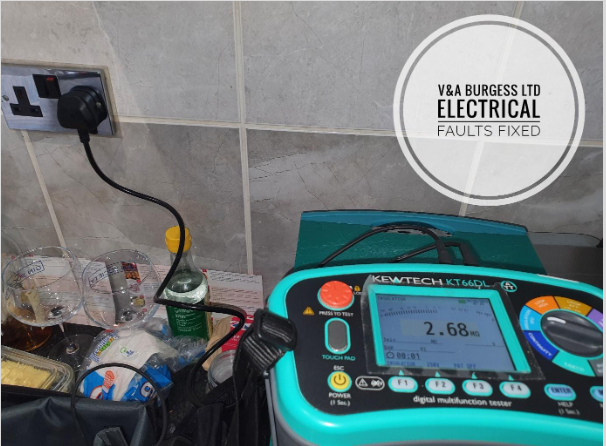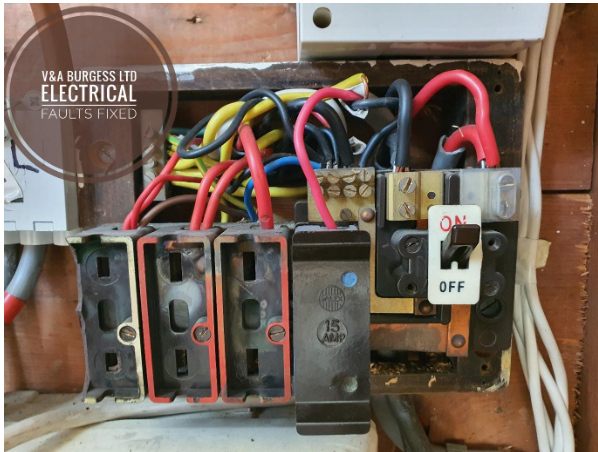New kitchen needs a new fuse box or consumer unit? - Electrical Faults Fixed
Table of Contents
- New Kitchen Needs a New Fuse Box or Consumer Unit?
- Running New Electrical Circuits into the Kitchen
- Earthing and Bonding Requirements
- What is a Consumer Unit, and Why is It Important?
- New Circuits for Electrical Hobs and Cookers
- Importance of Electrical Inspections Before and After Work
- Altering Old or Unsafe Wiring
- Compliance with Building Regulations
- Fuse Box Replacement: When and Why?
- Adding New Sockets and Appliances
- Where Can Plug Sockets Safely Be Installed in a Kitchen?
- What is the Minimum Number of Socket Outlets Required in a Kitchen?
- Avoiding Electrical Fires and Hazards
- Why Hire Professional Electricians?
- Best Time to Upgrade
1) New Kitchen Needs a New Fuse Box or Consumer Unit?
Your new kitchen MAY need a new fuse box when altering the electrical system. Contact with a reliable and trustworthy electrician is vital to gain an understanding of what is needed in your particular case.
When planning a new kitchen, most people focus on layouts, appliances, and finishes. However, an often-overlooked aspect of a kitchen renovation is the state of the home’s electrical system. With modern kitchens requiring more power for appliances and lighting than older kitchen designs, your old fuse box or consumer unit might not be up to the task. As an experienced electrician and tutor, I’ll Walk you through the key considerations and why upgrading your electrical panel is often a smart, and sometimes necessary, step.
Back to top2) Running New Electrical Circuits into the Kitchen
Modern kitchens demand a significant electrical load due to appliances like dishwashers, washing machines, ovens, and air conditioners. These devices often require separate or high powered circuits to ensure safe operation and prevent electrical overloads. Older homes, equipped with outdated fuse boxes or rewireable fuses, may lack the capacity to handle these new circuits. Adding additional circuits to an old fuse board can strain the system and increase the risk of electrical faults, such as blown fuses or short circuits. For safety reasons, a qualified electrician will assess whether your current fuse box or consumer unit is suitable for the new work. If it isn’t, a fuse box replacement or upgrade may be necessary to accommodate the increased electrical loads and to meet current standards.

(PHOTO: Insulation Resistance Test at a Socket Outlet)
Back to top3) Earthing and Bonding Requirements
When installing or altering electrical circuits in a kitchen, compliance with BS 7671, the UK’s wiring regulations, is essential. One vital aspect of these regulations is earthing and bonding to the gas meter water pipes, and other extraneous conductive parts. These safety measures protect against, and reduce the risk of, a fatal electric shock.

(PHOTO: Labelling required at Equipotential Bonding and Earthing Locations)
Older fuse boards in older homes often lack adequate earthing and bonding. This deficiency makes it essential to upgrade to a new consumer unit or breaker box with residual current devices (RCDs) and circuit breakers. These components provide improved protection by disconnecting the electrical supply quickly in the event of a fault.
Back to top4) What is a Consumer Unit, and Why is It Important?
A consumer unit, often referred to as a fuse box or electrical panel, is the hub of your home’s electrical system. It distributes electricity to the various circuits in your house, protecting them with devices like fuses, miniature circuit breakers, and RCDs.
Older fuse boxes may have screw-in fuses or rewireable fuses, which are less reliable and slower to react to faults. Modern consumer units with RCD devices and MCBs are far more effective at preventing electrical fires and protecting against electrical faults. The main difference between these and older models lies in their safety features and compliance with current safety standards.
Back to top5) New Circuits for Electrical Hobs and Cookers
Electric hobs and cookers are common in modern kitchens and often require their own dedicated circuits. Without these separate circuits, the risk of electrical overload increases, leading to potential power outages or even fire hazards. New consumer units offer additional space for these circuits, making them the best way to handle the electrical demands of a new kitchen safely.
When installing a gas hob, gas oven or electric hob or oven, it’s also a good idea to assess whether the main fuses, circuit breakers, consumer unit and wiring are in good condition. Faulty wiring or insufficient capacity can compromise the safety of your entire house.
Back to top6) Importance of Electrical Inspections Before and After Work
Before any electrical work begins, a professional electrician will conduct an Electrical Installation Condition Report (EICR). This inspection identifies potential issues like faulty wiring, old asbestos flash guards, or combustible materials near the fuse panel amongst other issues. Addressing these problems early ensures the safety of the new kitchen and compliance with building regulations.

(PHOTO: Consumer Unit Cover Removed for Inspection)
Following the installation, an Electrical Installation Certificate will normally be issued. This document confirms that the work complies with current safety standards and wiring regulations, providing peace of mind and some legal assurance.
Back to top7) Altering Old or Unsafe Wiring
Older homes often have wiring that doesn’t meet current standards. Faulty wiring, such as worn insulation or outdated materials, poses a significant fire hazard. Replacing these systems during a kitchen renovation is an excellent time to bring your entire house’s wiring up to code. This process may include replacing rewireable fuses, upgrading to a Type A RCD from a Type AC, and ensuring easy access to the main switch for emergencies.

(PHOTO: Old Fuse Box with Old Wiring requiring replacement)
Back to top8) Compliance with Building Regulations
In England and Wales, any electrical work in your kitchen must comply with Part P of the Building Regulations. This legal requirement ensures that all installations meet safety standards, protecting both homeowners and the public. Only certified electricians or professional electrical contractors should perform such work, as they have the necessary qualifications and experience to ensure compliance. You can check online to see if your electrician is competent and qualified.
Back to top9) Fuse Box Replacement: When and Why?
Upgrading to a new fuse box or consumer unit isn’t just about safety; it’s also about functionality and convenience. Here are some main reasons for a fuse box replacement:
Safety Standards: Older fuse boards may not meet current safety standards, lacking features like RCD protection or adequate space for new circuits.
Electrical Loads: Modern homes with powerful appliances require more power. A new fuse box upgrade can handle these increased electrical loads.
Faulty Components: Worn-out circuit breakers, larger fuses than the electrical designer intended or incorrect installation can compromise safety and efficiency.
Legal Compliance: Meeting wiring and building regulations is essential when performing new electrical work.
The average costs for a fuse box upgrade vary depending on the size of the house and the type of consumer unit installed. While the initial expense may seem high, the long-term benefits—including safety, reliability, and compliance—make it a worthwhile investment. Your electrician will be able to advise on the best type of consumer unit for you. Given that a consumer unit lasts around twice as long as a gas boiler, it makes them incredible value.
Back to top10) Adding New Sockets and Appliances
A new kitchen often means new sockets for appliances and gadgets. Ensuring each new appliance, such as a washing machine, tumble dryer or air conditioner, has its own circuit prevents electrical overloads and means minimal inconvenience when an electrical fault occurs. Professional electricians can design an electrical system that accommodates all your needs while maintaining safety standards. Extra circuits can cost more money in the short term but mean increased electrical circuit life and convenience in the long term.
Back to top11) Where Can Plug Sockets Safely Be Installed in a Kitchen?
Plug sockets in kitchens must be installed with safety and practicality in mind. According to UK regulations, sockets should be placed at least 300mm away from sinks and hobs to avoid exposure to water and heat. They should also be mounted at a height between 150mm and 1200mm from the floor to ensure accessibility while reducing the risk of accidental contact.
Sockets should never be installed directly above a sink or cooker, as these areas are prone to moisture and grease. For convenience, it’s a good idea to distribute sockets evenly around the kitchen and ensure they are easily accessible for appliances like kettles, toasters, and blenders.
12) What is the Minimum Number of Socket Outlets Required in a Kitchen?
The minimum number of socket outlets in a kitchen depends on its size and intended use. As a general guideline, a modern kitchen should have at least six double sockets to accommodate essential appliances and additional outlets for convenience. Larger kitchens or those with more electrical appliances may require more.

(PHOTO: Overloaded Plug Splitter in a Kitchen)
When planning the number of sockets, consider the layout and the location of fixed appliances like washing machines and ovens. Each major fixed appliance over 2kw (kilo watts) should have its own dedicated circuit, and additional sockets should be included for small appliances and occasional use.
Whilst there is no legal minimum number of plug sockets, it is advisable to install more than you think you will need to prevent excessive extension lead usage or overloading sockets with high-powered appliances.
Back to top13) Avoiding Electrical Fires and Hazards
One of the most significant risks in older homes is the presence of outdated electrical components. Fuse panels with asbestos flash guards, wooden backing or combustible materials increase the likelihood of electrical fires. A risk assessment performed by a qualified electrician can identify and mitigate these hazards. Electrical fires can cause significant damage and older wiring systems in particular should be regularly checked for safety by an electrician.
Back to top14) Why Hire Professional Electricians?
Working with certified electricians ensures your electrical installation is safe, compliant, and built to last. They provide expert advice on the best type of fuse box or consumer unit for your home, perform electrical testing to verify safety, and offer ongoing support.

(PHOTO: Electrician in a cupboard working on a consumer unit)
Back to top15) Best Time to Upgrade
Installing a new kitchen is a good time to evaluate your electrical system and consider a fuse box upgrade. Whether it’s to accommodate additional circuits, comply with building regulations, or enhance electrical safety, investing in a modern consumer unit is the best way to future-proof your home. It’s best to have electrical work carried out BEFORE installing an expensive kitchen as finding out that the electrics have problems AFTERWARDS can mean more expense!
Don’t leave your electrical safety to chance. Consult with professional electricians to ensure your kitchen’s electrical work is up to standard, giving you peace of mind and a safer home for years to come.
Back to top
Read more articles
- Log in to post comments


